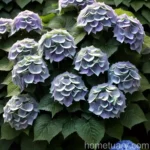Understanding the Bigleaf Hydrangea (Hydrangea macrophylla ‘Amethyst’)
The Hydrangea macrophylla, commonly known as the bigleaf hydrangea, is a beautiful and versatile flowering plant that belongs to the Hydrangeaceae family. The ‘Amethyst’ variety is known for its stunning amethyst-colored flowers and is a popular choice for many gardeners. In this comprehensive guide, we will delve into the culture, uses, care tips, and interesting facts about the bigleaf hydrangea.
What is the Bigleaf Hydrangea (Hydrangea macrophylla ‘Amethyst’)?
The bigleaf hydrangea, with its scientific name Hydrangea macrophylla, is a deciduous shrub that is native to Japan and Korea. This stunning plant is cherished for its large, showy flower heads and lush foliage, making it a favorite in many gardens and landscapes. The ‘Amethyst’ variety is specifically admired for its striking amethyst-colored blooms, adding a splash of vibrant color to the surroundings.
The bigleaf hydrangea is a versatile plant that can be used in various settings, from formal gardens to woodland areas, and also works well in containers. Its adaptability, combined with its eye-catching aesthetics, makes it a popular choice for both experienced and novice gardeners.
Key Takeaways – Bigleaf Hydrangea (Hydrangea macrophylla ‘Amethyst’)
Let’s explore the key aspects of the bigleaf hydrangea, including its culture, uses, care requirements, and other pertinent information.
Culture
As a plant scientist, understanding the cultural requirements of the bigleaf hydrangea is essential for ensuring its optimal growth and development. The following factors play a crucial role in the culture of this beautiful shrub:
Water
- The bigleaf hydrangea requires well-drained soil to thrive. Overly wet or waterlogged conditions can lead to root rot and other issues.
- Regular watering, particularly during dry spells or periods of drought, is essential for ensuring adequate moisture levels for the plant.
Sunlight
- While the bigleaf hydrangea appreciates some direct sunlight, it generally thrives in partial shade, especially during the hottest parts of the day.
- The dappled shade provided by trees or structures can create an ideal environment for the plant to flourish.
Fertilizer
- Applying a balanced, slow-release fertilizer in the spring can support the growth and blooming of the bigleaf hydrangea.
- Incorporating organic matter into the soil can also enhance the fertility and structure of the growing medium.
Soil
- The bigleaf hydrangea prefers slightly acidic to neutral soil with good organic content.
- Amending the soil with organic matter, such as compost or well-rotted manure, can improve its texture and nutrient availability.
Pruning
- Pruning the bigleaf hydrangea is typically done after the flowering period to remove spent blooms and shape the plant.
- It’s important to avoid extensive pruning in late summer or fall, as this can reduce the number of blooms in the following season.
Propagation
- Propagating the bigleaf hydrangea can be accomplished through methods such as softwood cuttings, division, or layering.
- Each propagation technique offers its advantages and can be employed based on the specific requirements and preferences of the gardener.
Container Popularity
- The bigleaf hydrangea is well-suited for container gardening, allowing individuals with limited space to enjoy its beauty on patios, balconies, or small outdoor areas.
- Selecting a large enough container with proper drainage is crucial for container cultivation.
Common Diseases
- Keeping a watchful eye for potential diseases, such as powdery mildew and leaf spot, can help in promptly addressing and managing these issues.
- Proper sanitation, adequate air circulation, and appropriate watering practices can contribute to disease prevention.
Common Pests
- Certain pests, including aphids, mites, and scale insects, may pose a threat to the bigleaf hydrangea.
- Regular monitoring and implementing integrated pest management strategies can aid in pest control.
Botanist’s Tips
To ensure the successful cultivation and maintenance of the bigleaf hydrangea, here are some valuable tips from a plant scientist:
- Selecting the right location with suitable light and soil conditions is crucial for the plant’s overall health and flowering performance.
- Regular monitoring of moisture levels, particularly during hot or dry periods, is important to prevent drought stress.
- Applying a layer of mulch around the base of the plant can help retain soil moisture, suppress weeds, and regulate soil temperature.
Fun Facts
As we explore the bigleaf hydrangea, here are some intriguing fun facts about this captivating plant:
- The color of the bigleaf hydrangea’s flowers can be influenced by soil pH, with acidic soils often resulting in blue flowers and alkaline soils yielding pink flowers.
- The large, striking flower heads of the bigleaf hydrangea are composed of both sterile and fertile flowers, creating a visually stunning display.
Now that we’ve unveiled the cultural aspects, uses, and other essential details about the bigleaf hydrangea, let’s delve further into its care requirements and interesting characteristics.
Links to External Resources
To expand your knowledge about the bigleaf hydrangea and further enhance your gardening expertise, I recommend exploring the following external resources:
By tapping into these valuable resources, you can gain deeper insights and practical tips for nurturing and enjoying the beauty of the bigleaf hydrangea.
Now that we’ve explored the general aspects and culture of the bigleaf hydrangea (Hydrangea macrophylla ‘Amethyst’), in the next section, we’ll delve into specific care tips and intriguing insights into this captivating plant.















